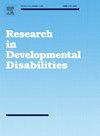自闭症中的恐音症:患病率、临床特征和合并症的系统综述
IF 2.6
2区 医学
Q1 EDUCATION, SPECIAL
引用次数: 0
摘要
恐音症以对特定声音的强烈情绪反应为特征,在自闭症谱系障碍(ASD)和相关的精神健康状况(如强迫症(OCD)、焦虑和抑郁)中得到越来越多的研究。自闭症患者通常感觉敏感,这可能使他们容易患恐音症。然而,自闭症中恐音症、感觉敏感性和精神合并症之间的关系仍未得到充分探讨。目的:本系统综述探讨自闭症患者恐音症的患病率、临床特征、合并症和治疗结果。它还探讨了恐音症和感觉敏感性之间的神经生物学联系及其对生活质量的影响,旨在为诊断和干预策略提供信息。方法按照PRISMA指南对7个数据库进行系统检索。使用已建立的诊断标准评估自闭症恐音症的研究也包括在内。使用ROBINS-I、AXIS、Venice标准和JBI工具评估偏倚风险。结果14项研究(n = 89,889名受试者)符合纳入标准。自闭症中恐音症的患病率从12.8% %到35.5% %不等,其中79% %患有恐音症的自闭症患者还患有精神合并症,如焦虑、强迫症和抑郁症。临床特征包括对特定声音触发(如进食、呼吸)的强烈情绪反应和日常功能的严重中断。21.4% %的病例报告感觉敏感,突出了自闭症中恐音症和更广泛的感觉处理挑战之间的重叠。只有两项干预研究:一项显示利培酮在降低恐音严重程度方面的疗效,另一项建议认知行为疗法(CBT)和耳鸣再训练疗法(TRT)作为潜在的管理策略。质量评估显示了不同程度的偏倚,特别是在观察性研究中,这些研究往往缺乏可靠的随机化和盲法。结论恐音症在自闭症患者中普遍存在,且常与精神疾病和感觉超敏症共存。需要标准化的诊断工具和量身定制的干预措施来改善临床结果。未来的研究应该探索纵向轨迹、遗传和环境影响,以及有效的管理策略,以解决恐音症、感觉敏感性和自闭症之间复杂的相互作用。本文章由计算机程序翻译,如有差异,请以英文原文为准。
Misophonia in autism: A systematic review of prevalence, clinical features, and comorbidities
Background
Misophonia, characterized by intense emotional reactions to specific sounds, is increasingly studied in autism spectrum disorder (ASD) and related mental health conditions such as obsessive-compulsive disorder (OCD), anxiety, and depression. Autistic individuals often have sensory sensitivities, which may predispose them to misophonia. However, the relationship between misophonia, sensory sensitivities, and psychiatric comorbidities in autism remains underexplored.
Aims
This systematic review examines the prevalence, clinical characteristics, comorbidities, and treatment outcomes of misophonia in autistic individuals and related conditions. It also explores the neurobiological links between misophonia and sensory sensitivities and their impact on quality of life, aiming to inform diagnostic and intervention strategies.
Methods
A systematic search was conducted across seven databases following PRISMA guidelines. Studies assessing misophonia in autism, using established diagnostic criteria, were included. The risk of bias was evaluated using ROBINS-I, AXIS, Venice criteria, and JBI tools.
Results
Fourteen studies (n = 89,889 participants) met inclusion criteria. Misophonia prevalence in autism ranged from 12.8 % to 35.5 %, with 79 % of autistic individuals with misophonia also experiencing psychiatric comorbidities such as anxiety, OCD, and depression. Clinical characteristics included intense emotional reactions to specific sound triggers (e.g., eating, breathing) and significant disruptions in daily functioning. Sensory sensitivities were reported in 21.4 % of cases, highlighting the overlap between misophonia and broader sensory processing challenges in autism. There were only two intervention studies: one demonstrating the efficacy of risperidone in reducing misophonia severity, and another suggesting cognitive-behavioral therapy (CBT) and tinnitus retraining therapy (TRT) as potential management strategies. Quality assessment revealed varying levels of bias, particularly in observational studies, which often lacked robust randomization and blinding.
Conclusion
Misophonia is prevalent in autism and frequently co-occurs with psychiatric conditions and sensory hypersensitivities. Standardized diagnostic tools and tailored interventions are needed to improve clinical outcomes. Future research should explore longitudinal trajectories, genetic and environmental influences, and effective management strategies to address the complex interplay between misophonia, sensory sensitivities, and autism.
求助全文
通过发布文献求助,成功后即可免费获取论文全文。
去求助
来源期刊

Research in Developmental Disabilities
Multiple-
CiteScore
5.50
自引率
6.50%
发文量
178
期刊介绍:
Research In Developmental Disabilities is aimed at publishing original research of an interdisciplinary nature that has a direct bearing on the remediation of problems associated with developmental disabilities. Manuscripts will be solicited throughout the world. Articles will be primarily empirical studies, although an occasional position paper or review will be accepted. The aim of the journal will be to publish articles on all aspects of research with the developmentally disabled, with any methodologically sound approach being acceptable.
 求助内容:
求助内容: 应助结果提醒方式:
应助结果提醒方式:


